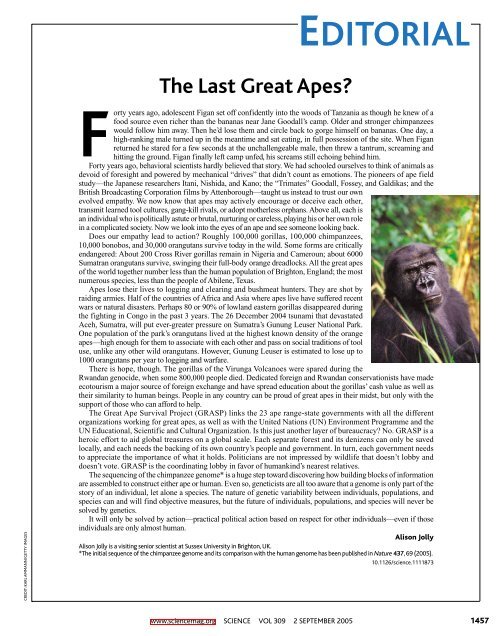THIS WEEK IN
THIS WEEK IN
THIS WEEK IN
You also want an ePaper? Increase the reach of your titles
YUMPU automatically turns print PDFs into web optimized ePapers that Google loves.
The Last Great Apes?<br />
EDITORIAL<br />
CREDIT: KARL AMMANN/GETTY IMAGES<br />
Forty years ago, adolescent Figan set off confidently into the woods of Tanzania as though he knew of a<br />
food source even richer than the bananas near Jane Goodall’s camp. Older and stronger chimpanzees<br />
would follow him away. Then he’d lose them and circle back to gorge himself on bananas. One day, a<br />
high-ranking male turned up in the meantime and sat eating, in full possession of the site. When Figan<br />
returned he stared for a few seconds at the unchallengeable male, then threw a tantrum, screaming and<br />
hitting the ground. Figan finally left camp unfed, his screams still echoing behind him.<br />
Forty years ago, behavioral scientists hardly believed that story. We had schooled ourselves to think of animals as<br />
devoid of foresight and powered by mechanical “drives” that didn’t count as emotions. The pioneers of ape field<br />
study—the Japanese researchers Itani, Nishida, and Kano; the “Trimates” Goodall, Fossey, and Galdikas; and the<br />
British Broadcasting Corporation films by Attenborough—taught us instead to trust our own<br />
evolved empathy. We now know that apes may actively encourage or deceive each other,<br />
transmit learned tool cultures, gang-kill rivals, or adopt motherless orphans. Above all, each is<br />
an individual who is politically astute or brutal, nurturing or careless, playing his or her own role<br />
in a complicated society. Now we look into the eyes of an ape and see someone looking back.<br />
Does our empathy lead to action? Roughly 100,000 gorillas, 100,000 chimpanzees,<br />
10,000 bonobos, and 30,000 orangutans survive today in the wild. Some forms are critically<br />
endangered: About 200 Cross River gorillas remain in Nigeria and Cameroun; about 6000<br />
Sumatran orangutans survive, swinging their full-body orange dreadlocks. All the great apes<br />
of the world together number less than the human population of Brighton, England; the most<br />
numerous species, less than the people of Abilene, Texas.<br />
Apes lose their lives to logging and clearing and bushmeat hunters. They are shot by<br />
raiding armies. Half of the countries of Africa and Asia where apes live have suffered recent<br />
wars or natural disasters. Perhaps 80 or 90% of lowland eastern gorillas disappeared during<br />
the fighting in Congo in the past 3 years. The 26 December 2004 tsunami that devastated<br />
Aceh, Sumatra, will put ever-greater pressure on Sumatra’s Gunung Leuser National Park.<br />
One population of the park’s orangutans lived at the highest known density of the orange<br />
apes—high enough for them to associate with each other and pass on social traditions of tool<br />
use, unlike any other wild orangutans. However, Gunung Leuser is estimated to lose up to<br />
1000 orangutans per year to logging and warfare.<br />
There is hope, though. The gorillas of the Virunga Volcanoes were spared during the<br />
Rwandan genocide, when some 800,000 people died. Dedicated foreign and Rwandan conservationists have made<br />
ecotourism a major source of foreign exchange and have spread education about the gorillas’ cash value as well as<br />
their similarity to human beings. People in any country can be proud of great apes in their midst, but only with the<br />
support of those who can afford to help.<br />
The Great Ape Survival Project (GRASP) links the 23 ape range-state governments with all the different<br />
organizations working for great apes, as well as with the United Nations (UN) Environment Programme and the<br />
UN Educational, Scientific and Cultural Organization. Is this just another layer of bureaucracy? No. GRASP is a<br />
heroic effort to aid global treasures on a global scale. Each separate forest and its denizens can only be saved<br />
locally, and each needs the backing of its own country’s people and government. In turn, each government needs<br />
to appreciate the importance of what it holds. Politicians are not impressed by wildlife that doesn’t lobby and<br />
doesn’t vote. GRASP is the coordinating lobby in favor of humankind’s nearest relatives.<br />
The sequencing of the chimpanzee genome* is a huge step toward discovering how building blocks of information<br />
are assembled to construct either ape or human. Even so, geneticists are all too aware that a genome is only part of the<br />
story of an individual, let alone a species. The nature of genetic variability between individuals, populations, and<br />
species can and will find objective measures, but the future of individuals, populations, and species will never be<br />
solved by genetics.<br />
It will only be solved by action—practical political action based on respect for other individuals—even if those<br />
individuals are only almost human.<br />
Alison Jolly<br />
Alison Jolly is a visiting senior scientist at Sussex University in Brighton, UK.<br />
*The initial sequence of the chimpanzee genome and its comparison with the human genome has been published in Nature 437, 69 (2005).<br />
10.1126/science.1111873<br />
www.sciencemag.org SCIENCE VOL 309 2 SEPTEMBER 2005 1457
















